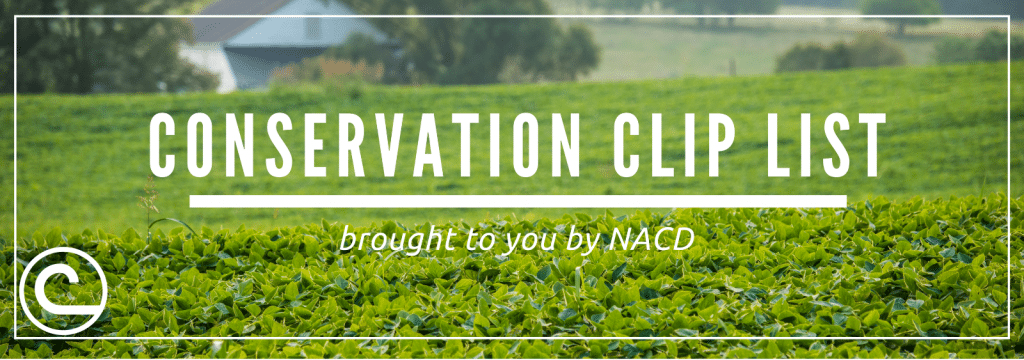
Conservation Clips is a weekly collection of articles distributed by NACD that provides our members and partners with the latest news in what’s driving conservation. These articles are not indicative of NACD policy and are the opinions of their authors, unless otherwise noted. If you have a relevant submission or need assistance with accessing articles, please contact the NACD Communications Team.
| WNAX Radio 570: NACD Asks Congress To Fully Fund Conservation Programs In FY Appropriations Bill 04/06/20 The National Association of Conservation Districts is one of 76 groups that’s written to Congress requesting full funding for conservation programs and technical assistance in the fiscal year 2021 Appropriations legislation. NACD President and Iowa producer Tim Palmer says conservation funding in the past has eclipsed $840 million. Feedstuffs: Ag groups seek conservation funding support Over 75 organizations ask Congress to reject any farm bill conservation program cuts in 2021 appropriations process. The National Association of Conservation Districts and other signatories called upon House and Senate appropriators to maintain discretionary U.S. Department of Agriculture conservation funding and reject any cuts to farm bill conservation programs through the fiscal 2021 appropriations process. No-Till Farmer: Building Soils, Getting Over the Hump with No-Tilling No-till practices, covers and better fertilizer management have been the right combination to return NACD Soil Health Champion Linus Rothermich’s rain-soaked clay soils to productivity. Kitsap Sun: Kitsap agriculture, backyard gardening seeing a surge during coronavirus pandemic Community-supported agriculture (CSA) has become increasingly popular as a means of obtaining food during the outbreak of COVID-19. Many local farmers donate what they grow to local food banks through the Farm to Food Bank program run by the Kitsap County Conservation District and funded by the Washington State Department of Agriculture. AgAlert: Farmers gain from soil-health practices Farmers who have adopted healthy soil practices such as growing cover crops or adding compost say the techniques save money on production costs while enhancing crop yields. ScienceDaily: Plant root hairs key to reducing soil erosion The tiny hairs found on plant roots play a pivotal role in helping reduce soil erosion, a new study has found. The research provides compelling evidence that when root hairs interact with the surrounding soil they reduce soil erosion and increase soil cohesion by binding soil particles. E&E News: Monarch butterfly gets protection in ‘historic’ deal (Subscriber Only) The Fish and Wildlife Service unveiled a sweeping, multistate plan to protect the monarch butterfly without adding it to the Endangered Species Act list. A long time in the making, the plan called, in part, a “candidate conservation” agreement unites state and federal officials with energy and transportation industry leaders on a common cause. Phys.org: Repurposing straw lets farmers grow more food with less water and fertilizer Straw left over from processing crops can be made into hydrogels—molecules that can absorb large amounts of water as well as fertilizers, then slowly release them as needed by crops. Indiana Public Radio: Farmers Who Rent Less Likely To Do Practices That Improve Soil, Water Almost half of all Indiana farmland isn’t owned by the farmer who works it — it’s rented out. In the same way people who rent apartments are unlikely to invest in them, studies show farmers who rent land are less likely to do conservation practices. The Salt Lake Tribune: Wildfire fighting plan eyes 1,000 miles of new fuel breaks, which could cut into sage grouse leks The agency said creating fuel breaks by clearing vegetation will help firefighters stop wildfires and protect key habitat for sage grouse and other wildlife on land also used by cattle ranchers and outdoor enthusiasts. ScienceDaily: Scientists discover legacy of past weather in stories of prairie plant restoration Today, tall grass prairies East of the Mississippi are virtually extinct. But some landowners want to return land throughout the Midwest to its incredibly deep roots, converting abandoned, depleted and fallow agricultural fields to native prairie — with varying degrees of success. Phys.org: How soil microbes help plants resist disease Plants can’t self-isolate during a disease outbreak, but they can get help from a friend—beneficial soil microbes help plants ward off a wide range of diseases. Now, Texas A&M AgriLife scientists have uncovered a major part of the process in which beneficial fungi help corn plants defend against pathogens. |